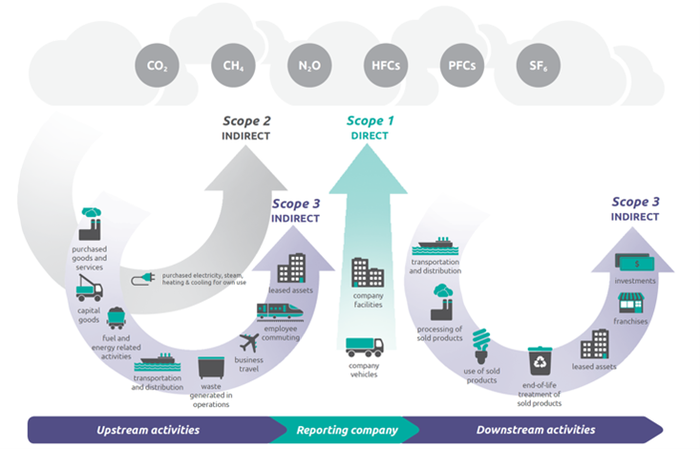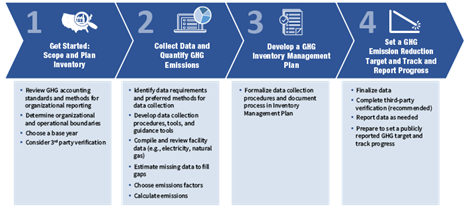Developing an Emissions Inventory Can Help Companies Tackle Scope 3 Targets
Earlier this year, the Securities and Exchange Commission proposed new rules that would provide information to investors on climate-related risks. This is in line with Larry Fink’s 2020 letter to CEOs where he stated that “[i]nvestors are increasingly…recognizing that climate risk is investment risk.” As Chairman and CEO of BlackRock, the largest money-management fund in the world with over $10 trillion in assets under management, Fink’s perspectives matter to publicly traded companies.
Earlier this year, the Securities and Exchange Commission proposed new rules that would provide information to investors on climate-related risks. This is in line with Larry Fink’s 2020 letter to CEOs where he stated that “[i]nvestors are increasingly…recognizing that climate risk is investment risk.” As Chairman and CEO of BlackRock, the largest money-management fund in the world with over $10 trillion in assets under management, Fink’s perspectives matter to publicly traded companies.
The proposed rules would require publicly traded companies to disclose Scope 1 and 2 greenhouse gas (GHG) emissions as well as Scope 3 GHG emissions, if material or targets have been established for Scope 3. Publicly traded waste companies will also be subject to these requirements. So what are these three emissions sources?
Scope 1 emissions are direct emissions that are owned by the company. These emissions include vehicle, boilers or the like. For waste companies, Scope 1 emissions usually include emissions from landfills, fleets and buildings.
Scope 2 are indirect emissions from purchased electricity, steam heating, cooling or other forms of energy. So while the electricity utilized does not result in any emissions at the point of use, emissions will occur upstream from that energy source.
Scope 3 are indirect emissions from upstream and downstream activities from a company’s value chain. This includes everything from transportation and distribution to business travel to leased facilities to waste generated from operations and the end-of life treatment of sold products.

Figure 1: GHG Scope 1, 2 & 3 (Source: Corporate Value Chain (Scope 3) Accounting Standard)
But even before SEC proposed its rule, a large number of companies already made public commitments to reduce their emissions. One initiative, Science Based Targets is working with over 3000 companies on emissions. These targets are voluntary, and, as such, they vary significantly from one company to another. Most have been focused on their Scope 1 emissions, although some also have goals related to their Scope 2 emissions. Less frequently, companies set reductions targets for their Scope 3 emissions. Part of the reason for more limited commitments to Scope 3 is that challenge in accounting for all Scope 3 emissions.
Determining the scope of upstream and downstream indirect emissions can be a challenge. Once determined, calculating them is another major hurdle. But most recognize that Scope 3 is a concern because, according to the Science Based Targets Initiative, in “most sectors these emissions make up the majority of the company’s inventory.”
For instance, Unilever determined that 65% of their GHG footprint are Scope 3 and Kraft estimates that 90% of its emissions were its supply chain under Scope 3. Consistent with that, Carbon Trust says that, generally Scope 3 emissions represent from 65% to 95% of a company’s carbon impact. Carbon Tracker says that about 85% of the emissions from a barrel of oil come when the oil is used in transportation, such as when the vehicle is driven. By comparison, ExxonMobil’s Scope 1 and Scope 2 together are minor. Still, the Carbon Disclosure Project (CDP) has over 3000 companies are reporting Scope 3 emissions.
Unlike the oil and gas industry, the waste and recycling industry, however, do not sell products that have downstream emissions and as a result may have higher Scope 1 emissions than Scope 3 emissions. A significant portion of the industry’s emissions stem from landfill operations. While landfills typically collect landfill gas and control landfills gas, some fugitive emissions from landfills occur. These fugitive emissions count as towards the industry’s Scope 1 emissions. For companies that own landfills, fugitive emissions can represent more than 80% of their total Scope 1 emissions.
Because the emissions are fugitive, they are difficult to quantify and have traditionally been estimated through modeling. Republic Services began utilizing a modeling methodology known as SWICS (Solid Waste Industry for Climate Solutions) that takes into account a landfill’s gas collection effectiveness and efficiency as well as its cover system.
Both WM and Republic recognize the challenge of quantifying fugitive emissions in their 2021 Sustainability Reports. As such, the industry is prioritizing the importance of establishing a better method to measure, which will lead to better management of fugitive emissions. In fact, WM established a goal of developing a system for measuring fugitive emissions by 2025. And Republic Services also noted its efforts to invest in emissions measurement and detection technologies.
Nonetheless, efforts to track Scope 3 emissions may benefit from collaboration. Often one company’s supply chain may overlap its competitors leading to efforts such as the Sustainable Apparel Coalition. This coalition saw companies within an industry work together on understanding their Scope 3 emissions. Since they use many of the same suppliers and transporters, combining efforts to develop a common methodology and engaging suppliers makes sense. By pooling their efforts, it can ease the burden for obtaining information for Scope 3 calculations and also relieve the suppliers from responding to multiple sources.
Once calculated, how to control them presents a third challenge. As a result, most companies have opted out of setting Scope 3 targets even when calculating them. And just like the aphorism, one man’s trash is another man’s treasure: one company’s Scope 1 emissions are another company’s Scope 3 emissions. Combined with the increasing number of organizations that have established targets, the industry needs to be prepared to respond to requests for Scope 3 from their customers. Already, Republic Services has noted this in their sustainability report by acknowledging that to support their customers, they developed a GHG calculator that estimates their customer’s Scope 3 waste and recycling emissions.
Developing a company-specific GHG inventory can be challenging. Many companies utilize the global standards developed by the World Resources Institute (WRI) and the World Business Council for Sustainable Development (WBCSD) to determine their emissions. EPA lays out the following process for developing a GHG inventory.

For the first step, scope and plan inventory, EPA recommends reviewing GHG accounting standards and methods for organizational reporting. From there, companies should determine organizational and operational boundaries, establish a base year and select a 3rd party verifier to confirm the data.
The second step, collect data and quantify GHG emissions, requires companies to start by identifying data requirements and data collection methods. They should establish their data collection procedures, tools, and internal guidance materials. The company needs to then compile and review facility data, determine gaps and make estimates for missing data. They should select emissions factors and finally calculate emissions.
For help with developing Scope 1 inventories, resources are available, such as guidance documents released by EPA in December 2020 on Stationary Combustion, Mobile Combustion Sources and fugitive emissions from refrigeration, air conditioning, fire suppression and industrial gases. EPA also developed a Scope 2 guidance on purchased electricity, steam, heat or cooling. The GHG Protocol has published Scope 2 Guidance that standardizes how corporations measure emissions from purchased or acquired electricity, steam, heat, and cooling.
And EPA’s Scope 3 Inventory Guidance provides resources and emission factors to help organizations develop a scope 3 emissions inventory.
The third step is to develop a GHG Inventory Management Plan (IMP) which is a formal data collection and documentation. EPA makes available an IMP Checklist that can be used as a guide for creating an IMP or pulling together existing documents.
The final step is to set a GHG Emission Reduction Target and Track and Report Progress. According to World Wildlife Fund for Nature (WWF), in 2021, the number of Science Based Targets Initiative (SBTi) companies doubled to 2,253 including 1,082 companies with approved targets and 1,171 that committed to set science-based targets and in the first quarter of 2022, almost 500 companies have set or committed to set science-based targets.
EPA recommends public declaring GHG reduction targets to provide transparency, accountability, and credibility to the target setting process. Targets should include a base and target year and should be aggressive. The base year is the year against which GHG reductions are tracked. For example, WM has a target to cut fleet emissions by 45% by 2038, against a 2010 baseline. And Republic Services’ goal is to reduce absolute Scope 1 and 2 emissions 35% by 2030, against a 2017 baseline. Waste Connections established 15 year goals in 2020 to increase resource recycling by 50%. And Casella set a target to increase their net climate benefit factor five-fold by 2030.
To help set targets, EPA developed two resources. The first is a self-assessment responsive to organizations’ interests in benchmarking their GHG management approaches. Based on an analysis of more than 500 publicly-reporting companies in 2017, the Corporate GHG Inventorying and Target Setting Self-Assessment can be used as a communication and management resource and a high-level benchmarking assessment. It aims to help them identify which inventorying and target setting actions reflect common business practices today and validate additional inventorying and target-setting behaviors that position them for more cost-effective GHG emission reductions. Results from this self-assessment can also highlight how other companies develop their inventories and set GHG reduction targets.
EPA’s second resource is an Excel tracking form, the Annual GHG Inventory Summary and Target Tracking Form, to summarize and track emissions over time against an emissions reduction target.
Developing a GHG inventory can be a challenging endeavor, but resources are available. And, while not all companies will be subject to the SEC’s proposed climate disclosure requirements, to remain competitive and responsive to customers, developing a GHG Inventory should be a consideration.
About the Author
You May Also Like


